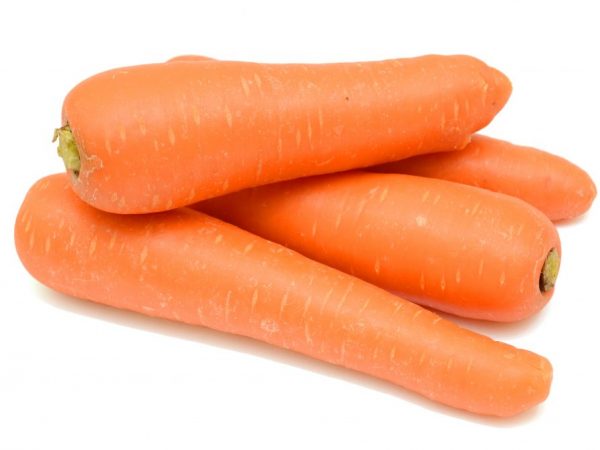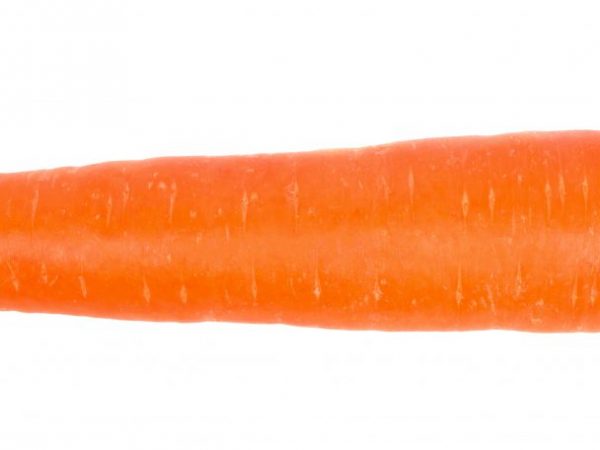Growing varieties of carrots Laguna F1
In regions with short summers, vegetables are grown that ripen quickly and have time to acquire the maximum of positive qualities. Among the variety of varieties of root crops, the Laguna carrot stands out.

Growing varieties of carrots Laguna F1
Variety characteristic
The Laguna F1 carrot variety was bred in a hybrid way by VNIISSOK breeders in 2007. The seeds are created on the basis of the Nantskaya-4 variety.
Lagoon is an early maturing carrot, ready to eat 80-85 days after planting. Productivity is high - up to 7 kg / m².
When ripe, carrots acquire the same shape, equalize in size, become almost identical in color. The leaves of the tops are bright green, rushing up.
The cultivar is known for its small pith, which is practically absent in minimum-sized root crops. It grows from 15 to 20 cm, under good conditions - up to 27 cm.
The shape of the carrots is an even cylinder without curvature, a short tip. The color is close to intense orange. The fruits are sweet and juicy, thanks to the large amount of carotene in the root vegetables.
Growing carrots
A comfortable place for planting carrots is a sunny place with an average occurrence of groundwater - from 0.8 to 2.5 m deep.
Among the varieties of soils suitable for planting are sandy-clayey, clay-sandy with a predominance of the dusty part, soils of organic origin are peat bogs. The acidity level should not exceed pH 6-6.5. Plants are sometimes sown before winter so that they get enough moisture at the time of germination.
Laguna F1 carrots grow well in places where cultivated crops were cultivated last year: cabbage, cucumbers, leeks, tomatoes, as well as continuous crops: winter wheat and legumes. Refrain from planting carrots in places where organic fertilizers were applied in the first year, potatoes, celery, parsley and beets were grown. Such zones are used for sowing after 3-4 years.
Before planting, the soil is fertilized. For winter sowing, phosphorus compounds are used. Potash fertilizers are applied to heavy soils in autumn and spring, nitrogen-containing fertilizers - in spring, just before planting. Often, saltpeter or diluted urea is used to improve the mineral composition of the soil.
For spring planting, the end of April – early May is suitable, when the soil warms up to a temperature above 8 ° С, to obtain brightly colored root crops, they wait until the soil warms up to 16 ° С-22 ° С.
The beds are outlined with a depth of no more than 2 cm with a distance of 15 cm from each other. Watered with warm, preferably rainwater, settled water. Carrot seeds Laguna F1 are sown directly into the ground using a sowing machine or strainer, covered with a layer of soil. Seeds germinate in 12-14 days, with stable heat - in 10 days.
Watering and feeding
Water the carrots regularly, but in well-defined quantities. The first watering is done before sowing at a rate of 3 l / m². The second is carried out in 10-14 days, when the first shoots appear, in the amount of 6-10 l / m². During subsequent watering, if the soil is moist, it is not recommended to add water.
During the period of active growth, carrots are fed with fertilizers based on humus. They are able to deliver the minerals and trace elements necessary for the root crop and not provoke mutations. On the 20-30th day after sowing, fertilizers are used, which include potassium and sodium, in order to prevent the appearance of rotting of root crops during abundant soil moisture.
Diseases and pests

Disease resistant
According to the description, the Laguna F1 carrot variety is resistant to several diseases. Sometimes the lack of preventive measures provokes disease. Common ailments include:
- Septoria. In a greenhouse or greenhouse, when constant air humidity is present, there is a possibility that plants will be damaged by this disease. The symptom is the appearance of whitish dry spots on the tops closer to the base of the stems. To get rid of them, the carrots are sprayed with a Bordeaux mixture: a small amount of copper sulfate is dissolved in milk of lime. If necessary, repeat the action after 10 days.
- Black rot. A rare disease for a crop growing in good conditions. It appears as black spots on the root crop. In such a situation, the infected plants are disposed of. To prevent the onset of the disease, the seeds are treated with Tigama before planting.
Carrots are susceptible to pests, especially aphids. The parasite sucks the sap from the leaves, thereby slowing down the growth and development of the plant. As a result, it withers. To get rid of pests, the outer part of the root crop and tops are treated with the combined Caesar remedy or folk methods:
- 200 g of wood ash is dissolved in a bucket of water;
- take 1 tbsp. chopped garlic in 10 liters of water, insist for 3 days, add 100 g of laundry soap;
- use 25 g of ammonia per 5 liters of water.
Prophylaxis
To reduce the likelihood of infection of carrots with diseases and pests, adhere to the following rules:
- they adhere to the correct crop rotation: they do not plant crops in places where last year they bred vegetables prone to similar ailments;
- timely use of phosphorus, ammonia and potash fertilizers;
- disinfect the soil before planting and the vegetable store before wintering;
- harvesting is carried out in dry sunny weather, trying not to injure the plants;
- adhere to the optimal storage conditions for root crops - at a temperature of 1 ° C-2 ° C and an air humidity of 80-85%.
Conclusion
Laguna F1 is a high-yielding root vegetable that is healthy for home consumption. According to the description, its main advantages are early maturity and insensitivity to major diseases and pests.
To grow and maintain a rich harvest, they monitor the implementation of the rules of planting, care and prevention. Then the efforts and time invested in the garden will bring results in the form of bright root crops that are ideal in appearance and sweet to the taste.


